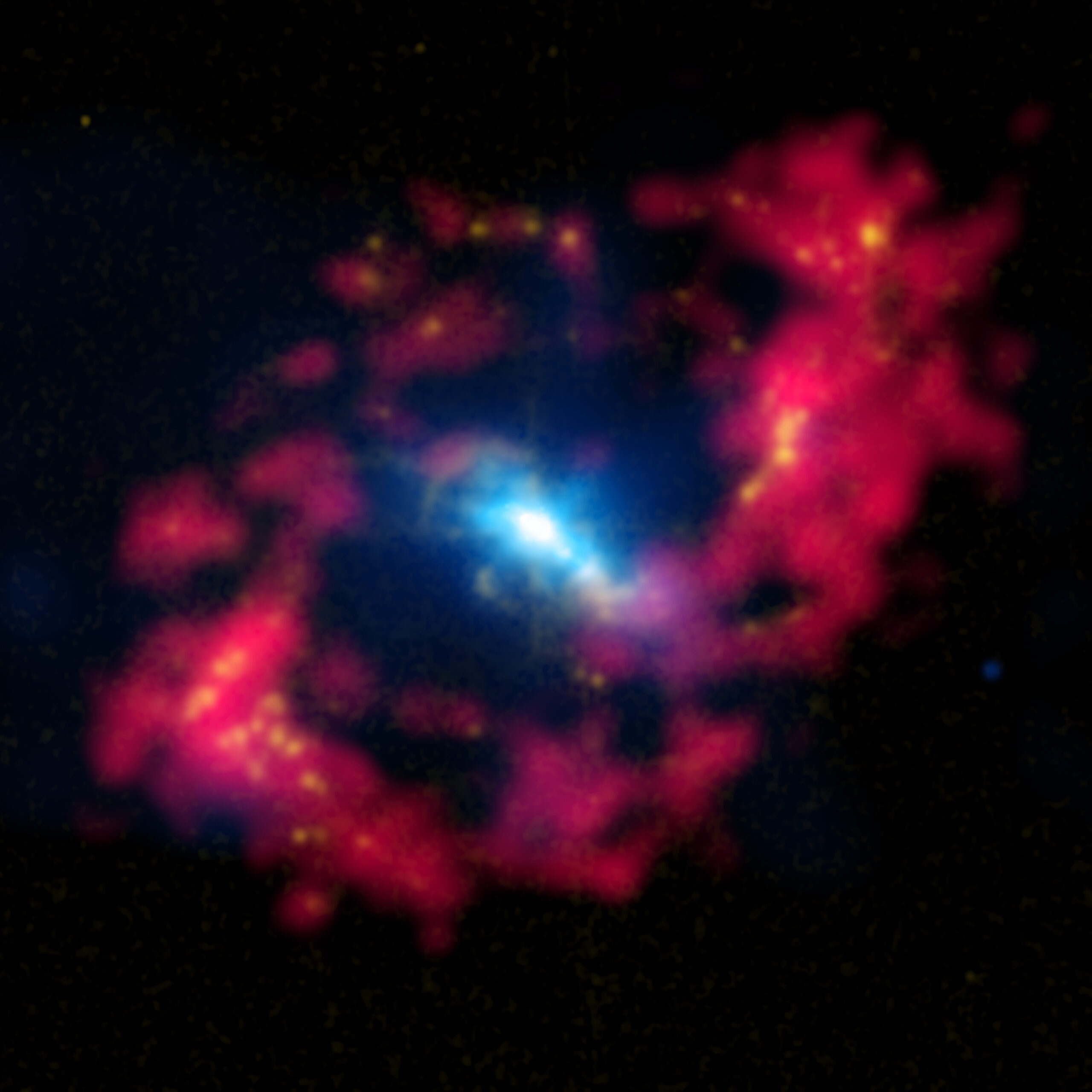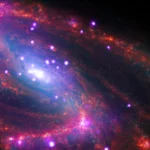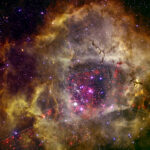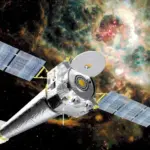This composite image shows the central region of the spiral galaxy NGC 4151, dubbed the “Eye of Sauron” by astronomers for its similarity to the eye of the malevolent character in “The Lord of the Rings”. In the “pupil” of the eye, X-rays (blue) from the Chandra X-ray Observatory are combined with optical data (yellow) Showing Positively Charged Hydrogen (“H II”) from observations with the 1-meter Jacobus Kapteyn Telescope on La Palma. The red around the pupil shows neutral hydrogen detected by radio observations with the NSF’s Very Large Array. This neutral hydrogen is part of a structure near the centre of NGC 4151 that has been distorted by Gravitational interactions with the rest of the galaxy, and includes material falling towards the centre of the galaxy. The yellow blobs around the red ellipse are regions where Star Formation has recently occurred.
A recent study has shown that the X-ray emission was likely caused by an outburst powered by the Supermassive Black Hole located in the white region in the centre of the galaxy. Evidence for this idea comes from the elongation of the X-rays running from the top left to the bottom right and details of the X-ray spectrum. There are also signs of interactions between a central source and the surrounding gas, particularly the yellow arc of H II emission located above and to the left of the black hole.
Two different scenarios to explain the X-ray emission have been proposed. One possibility is that the central black hole is growing much more quickly about 25,000 years ago (in Earth’s time frame). The radiation from the material falling onto the black hole was so bright that it stripped electrons away from the atoms in the gas in its path. X-rays were then emitted when electrons recombined with these ionized atoms.
The second possibility also involved a substantial inflow of material into the black hole relatively recently. In this scenario, the energy released by material flowing into the black hole in an Accretion Disk created a vigorous outflow of gas from the surface of the disk. This out flowing gas directly heated gas in its path to X-Ray Emitting Temperatures. Unless the gas is confined somehow, it would expand away from the region in less than 100,000 years. In both of these scenarios, the relatively short amount of time since the last episode of high activity by the black hole may imply such outbursts occupy at least about 1% of the black hole’s lifetime.
NGC 4151 is located about 43 million light years away from the Earth and is one of the nearest galaxies that contains an actively growing black hole. Because of this proximity, it offers one of the best chances of studying the interaction between an active supermassive black hole and the surrounding gas of its host galaxy. Such interaction, or “feedback”, is recognized to play a key role in the growth of supermassive black holes and their host galaxies. If the X-ray emission in NGC 4151 originates from hot gas heated by the outflow from the central black hole, it would be strong evidence for feedback from active black holes to the surrounding gas on galaxy scales. This would resemble the larger scale feedback, observed on galaxy cluster scales, from active black holes interacting with the surrounding gas, as seen in objects like the Perseus Cluster.
These results were published in the August 20, 2010 issue of The Astrophysical Journal Letters. The authors were Junfeng Wang and Giuseppina Fabbiano from the Harvard Smithsonian Center for Astrophysics (CfA), Guido Risaliti from CfA and INAF-Arcetri Observatory, in Firenze, Italy. Other authors were Martin Elvis from CfA, Carole Mundell from Liverpool John Moores University in Birkenhead, UK, Gaelle Dumas and Eva Schinnerer from the Max Planck Institute for Astrophysics in Heidelberg, Germany. And Andreas Zezas, from CfA and the University of Crete in Greece.












![Space Streams - Nebula [Ambient] image](https://space-streams.com/wp-content/uploads/2024/11/space-streams-nebula-150x150.png)






































